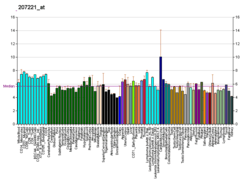F2RL3
Protease-activated receptor 4 (PAR-4), also known as coagulation factor II (thrombin) receptor-like 3, is a protein that in humans is encoded by the F2RL3 gene.[5]
Function
Coagulation factor II (thrombin) receptor-like 3 (F2RL3) is a member of the large family of 7-transmembrane-region receptors that couple to guanosine-nucleotide-binding proteins. F2RL3 is also a member of the protease-activated receptor family. F2RL3 is activated by proteolytic cleavage of its extracellular amino terminus. The new amino terminus functions as a tethered ligand and activates the receptor. F2RL3 is activated by thrombin and trypsin.[5]
gollark: I'm not actually sure.
gollark: Really? Huh.
gollark: I might not actually be playing either, oops.
gollark: * yours
gollark: * uoeus
See also
References
- GRCh38: Ensembl release 89: ENSG00000127533 - Ensembl, May 2017
- GRCm38: Ensembl release 89: ENSMUSG00000050147 - Ensembl, May 2017
- "Human PubMed Reference:". National Center for Biotechnology Information, U.S. National Library of Medicine.
- "Mouse PubMed Reference:". National Center for Biotechnology Information, U.S. National Library of Medicine.
- "Entrez Gene: F2RL3 coagulation factor II (thrombin) receptor-like 3".
Further reading
- Leger AJ, Covic L, Kuliopulos A (2006). "Protease-activated receptors in cardiovascular diseases". Circulation. 114 (10): 1070–7. doi:10.1161/CIRCULATIONAHA.105.574830. PMID 16952995.
- Xu WF, Andersen H, Whitmore TE, et al. (1998). "Cloning and characterization of human protease-activated receptor 4". Proc. Natl. Acad. Sci. U.S.A. 95 (12): 6642–6. doi:10.1073/pnas.95.12.6642. PMC 22580. PMID 9618465.
- Kahn ML, Zheng YW, Huang W, et al. (1998). "A dual thrombin receptor system for platelet activation". Nature. 394 (6694): 690–4. doi:10.1038/29325. PMID 9716134.
- Kahn ML, Hammes SR, Botka C, Coughlin SR (1998). "Gene and locus structure and chromosomal localization of the protease-activated receptor gene family". J. Biol. Chem. 273 (36): 23290–6. doi:10.1074/jbc.273.36.23290. PMID 9722561.
- Kahn ML, Nakanishi-Matsui M, Shapiro MJ, et al. (1999). "Protease-activated receptors 1 and 4 mediate activation of human platelets by thrombin". J. Clin. Invest. 103 (6): 879–87. doi:10.1172/JCI6042. PMC 408153. PMID 10079109.
- Andersen H, Greenberg DL, Fujikawa K, et al. (1999). "Protease-activated receptor 1 is the primary mediator of thrombin-stimulated platelet procoagulant activity". Proc. Natl. Acad. Sci. U.S.A. 96 (20): 11189–93. doi:10.1073/pnas.96.20.11189. PMC 18009. PMID 10500152.
- Sambrano GR, Huang W, Faruqi T, et al. (2000). "Cathepsin G activates protease-activated receptor-4 in human platelets". J. Biol. Chem. 275 (10): 6819–23. doi:10.1074/jbc.275.10.6819. PMID 10702240.
- Nakanishi-Matsui M, Zheng YW, Sulciner DJ, et al. (2000). "PAR3 is a cofactor for PAR4 activation by thrombin". Nature. 404 (6778): 609–13. doi:10.1038/35007085. PMID 10766244.
- Miike S, McWilliam AS, Kita H (2002). "Trypsin induces activation and inflammatory mediator release from human eosinophils through protease-activated receptor-2". J. Immunol. 167 (11): 6615–22. doi:10.4049/jimmunol.167.11.6615. PMID 11714832.
- Asokananthan N, Graham PT, Fink J, et al. (2002). "Activation of protease-activated receptor (PAR)-1, PAR-2, and PAR-4 stimulates IL-6, IL-8, and prostaglandin E2 release from human respiratory epithelial cells". J. Immunol. 168 (7): 3577–85. doi:10.4049/jimmunol.168.7.3577. PMID 11907122.
- Henriksen RA, Hanks VK (2002). "PAR-4 agonist AYPGKF stimulates thromboxane production by human platelets". Arterioscler. Thromb. Vasc. Biol. 22 (5): 861–6. doi:10.1161/01.ATV.0000014742.56572.25. PMID 12006403.
- Covic L, Singh C, Smith H, Kuliopulos A (2003). "Role of the PAR4 thrombin receptor in stabilizing platelet-platelet aggregates as revealed by a patient with Hermansky-Pudlak syndrome". Thromb. Haemost. 87 (4): 722–7. PMID 12008957.
- Strausberg RL, Feingold EA, Grouse LH, et al. (2003). "Generation and initial analysis of more than 15,000 full-length human and mouse cDNA sequences". Proc. Natl. Acad. Sci. U.S.A. 99 (26): 16899–903. doi:10.1073/pnas.242603899. PMC 139241. PMID 12477932.
- Owen WG (2003). "PAR-3 is a low-affinity substrate, high affinity effector of thrombin". Biochem. Biophys. Res. Commun. 305 (1): 166–8. doi:10.1016/S0006-291X(03)00732-0. PMID 12732212.
- Adam F, Verbeuren TJ, Fauchère JL, et al. (2003). "Thrombin-induced platelet PAR4 activation: role of glycoprotein Ib and ADP". J. Thromb. Haemost. 1 (4): 798–804. doi:10.1046/j.1538-7836.2003.00138.x. PMID 12871418.
- Wu CC, Hwang TL, Liao CH, et al. (2004). "The role of PAR4 in thrombin-induced thromboxane production in human platelets". Thromb. Haemost. 90 (2): 299–308. doi:10.1267/THRO03020299. PMID 12888878.
- Kawai T, Akira S, Reed JC (2003). "ZIP kinase triggers apoptosis from nuclear PML oncogenic domains". Mol. Cell. Biol. 23 (17): 6174–86. doi:10.1128/MCB.23.17.6174-6186.2003. PMC 180930. PMID 12917339.
- Jacques SL, Kuliopulos A (2004). "Protease-activated receptor-4 uses dual prolines and an anionic retention motif for thrombin recognition and cleavage". Biochem. J. 376 (Pt 3): 733–40. doi:10.1042/BJ20030954. PMC 1223816. PMID 13678420.
- Han Y, Nurden A, Combrié R, Pasquet JM (2004). "Redistribution of glycoprotein Ib within platelets in response to protease-activated receptors 1 and 4: roles of cytoskeleton and calcium". J. Thromb. Haemost. 1 (10): 2206–15. doi:10.1046/j.1538-7836.2003.00436.x. PMID 14521606.
This article incorporates text from the United States National Library of Medicine, which is in the public domain.
This article is issued from Wikipedia. The text is licensed under Creative Commons - Attribution - Sharealike. Additional terms may apply for the media files.




